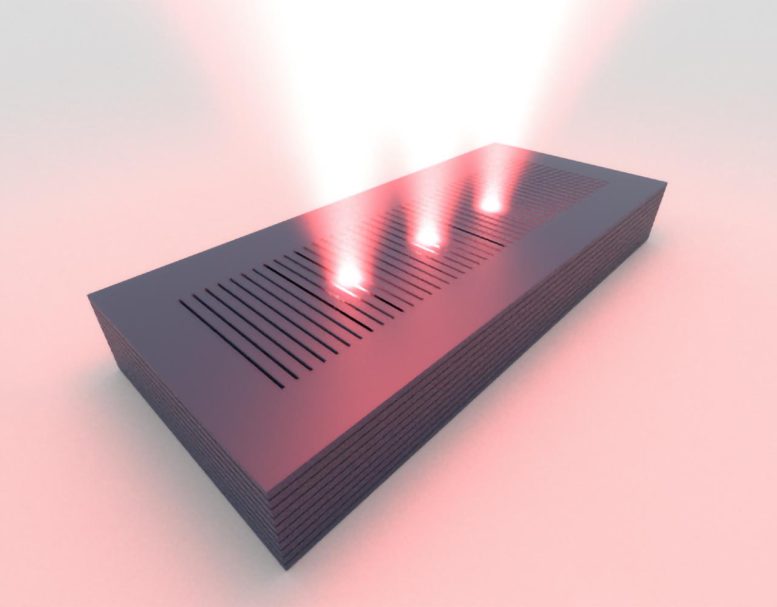

Subwavelength grated waveguide supporting polariton droplets (visualization: Antonio Gianfrate, Credit: CNR Nanotec, edited
Scientists have advanced the field by stabilizing exciton-polaritons in semiconductor photonic gratings, achieving long-lived and optically configurable quantum fluids suitable for complex system simulations.
Researchers from CNR Nanotec in Lecce and the Faculty of Physics at the University of Warsaw used a new generation of semiconductor photonic gratings to optically tailor complexes of quantum droplets of light that became bound together into macroscopic coherent states. The research underpins a new method to simulate and explore interactions between artificial atoms in a highly reconfigurable manner, using optics. The results have been published in the prestigious journal Nature Physics.
Quantum Simulation Technologies
Condensed matter systems and photonic technologies are regularly used by researchers to create microscale platforms that can simulate the complex dynamics of many interacting quantum particles in a more accessible setting. Some examples include ultracold atomic ensembles in optical lattices, superconducting arrays, and photonic crystals and waveguides. In 2006 a new platform emerged with the demonstration of macroscopically coherent quantum fluids of exciton-polaritons to explore many-body quantum phenomena through optical techniques.
Exciton-Polaritons and Quantum Fluids
When a piece semiconductor is placed between two mirrors – an optical microresonator – the electronic excitations within can become strongly influenced by photons trapped between the mirrors. The resulting new bosonic quantum particles, known as exciton-polaritons (or polaritons for short), can under the right circumstances undergo a phase transition into a nonequilibrium Bose-Einstein condensate and form a macroscopic quantum fluid or a droplet of light. Quantum fluids of polaritons have many salient properties, one being that they are optically configurable and readable, permitting easy measurements of the polariton dynamics. This is what makes them so advantageous to simulate many-body physics.
Stability and Pumping Challenges
Polariton condensates must be continuously optically pumped with external lasers to replenish particles, otherwise the condensate dissipates within picoseconds. However, the harder you pump the condensate the more energetic it becomes due to repulsive interparticle forces, leading to particles escaping the condensate and subsequent decay of spatial correlations. This is a fundamental problem for optically programmable polariton simulators. Scientists needed to come up with a way to make the condensate more stable and long lived, while still being optically pumped.
Advances in Polariton Stability
Scientists from CNR Nanotec in Lecce and the Faculty of Physics at the University of Warsaw, achieved this goal using a new generation of semiconductor photonic gratings. In their paper titled “Reconfigurable quantum fluid molecules of bound states in the continuum,” published in Nature Physics, they used subwavelength properties of the photonic grating to imbue polaritons with new properties. First, the polaritons could be driven to condense into an ultralong lifetime state known as bound state in the continuum (BIC). The fascinating thing about BICs is that they are mostly non-radiative due to symmetry enforced protection from the outside continuum of photonic modes. Second, the polaritons obtained a negative effective mass due to the dispersion relation coming from the grating. This meant that the pumped polaritons could not escape so easily through normal decay channels anymore. Now, the researchers possessed polariton fluids that were both extremely long lived and safely confined using only optical techniques.
Combined, these mechanisms allowed Antonio Gianfrate and Danielle Sanvitto at CNR Nanotec in Lecce to optically pump multiple polariton droplets that could interact and hybridize into macroscopic complexes. They could tailor and reversibly configure molecular arrangements and chains using this new form of artificial atoms: condensates of negative-mass BIC polaritons. The BIC property provided polaritons with much longer lifetimes whereas the negative mass property caused them to become optically trapped. The findings were supported by a BIC Dirac-polariton theory developed between Helgi Sigurdsson (University of Warsaw), Hai Chau Nguyen (University of Siegen, Germany), and Hai Son Nguyen (Univ Lyon, France).
The ultimate advantage of the platform is that the artificial quantum complexes can be all-optically programmed yet they retain very high lifetimes because of their protection from the continuum. This could lead to a new venture into optically programmable large-scale quantum fluids defined by unprecedented coherence scales and stability for structured nonlinear lasing and polariton-based simulation of complex systems.
“There are still several interesting ways to explore in this artificial polaritonic Dirac system. As an example, the coupling mechanism between polariton droplets along and perpendicular to the grating direction is very different. Along the waveguide, polaritons are effectively negative mass particles strongly bound to their pump spot. Perpendicular to the waveguide they move as positive mass particles undergoing ballistic transport. The mixture of these two mechanisms opens a new window to look at emergent behaviours of synchrony and pattern formation in structured polariton quantum fluids” concludes Helgi Sigurðsson from the Faculty of Physics, University of Warsaw.
Reference: “Reconfigurable quantum fluid molecules of bound states in the continuum” by Antonio Gianfrate, Helgi Sigurðsson, Vincenzo Ardizzone, Hai Chau Nguyen, Fabrizio Riminucci, Maria Efthymiou-Tsironi, Kirk W. Baldwin, Loren N. Pfeiffer, Dimitrios Trypogeorgos, Milena De Giorgi, Dario Ballarini, Hai Son Nguyen and Daniele Sanvitto, 4 January 2024, Nature Physics.
DOI: 10.1038/s41567-023-02281-3
An international team of scientists conducted research supported by the National Science Center grant (2022/45/P/ST3/00467) co-funded by the European Union Framework Programme for Research and Innovation Horizon 2020 under the Marie Sklodowska-Curie grant agreement (No. 945339).
